Gennette Cooley
30 December 1836 – 6 February 1927
Gennette
Cooley was a descendant of the prominent early emigrant families of
New England going back several generations to the 1600s. She was the
daughter of John William Cooley and Hannah Gould. John William Cooley
was born November 29, 1811 in New Haven, Oswego County, New York to
Daniel and Mary Butler Cooley. Hannah Gould was born January 10, 1815
to Seth Burr Gould, and Hannah Sager at Cramahe, New Castle District,
Upper Canada (now Northumberland County, Ontario), although they came from
Connecticut.
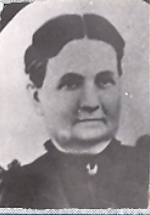
At some point in time John went to Cramahe, on the north shore of Lake Ontario, where at the age of 24 he married Hannah Gould on January 10, 1836 which happened to be her 21st birthday. After their marriage they made their home in New Castle. It was later that year that their first child, Gennette was born on December 20, 1836 at New Castle, Northumberland County, New Brunswick, then known as Upper Canada.
It was in Canada that Gennette's parents first heard of and joined the Church of Jesus Christ of Latter Day Saints. Hannah's older brother, John, had joined the church five years earlier. When Hannah joined the church, resentment was high against the Mormons. Her family was so bitter that they disinherited her. She must have had great faith to have left her family and deprived herself of the easy living and comforts of wealth.
In 1840, John
and Hannah decided to move to
Nauvoo to be with the Saints there. Their journey took them by way of
the many canals and rivers of the Northeast by boat. Just before they
landed, one of Hannah's trunks fell overboard. It was recovered and
when they came ashore the contents were spread to dry. 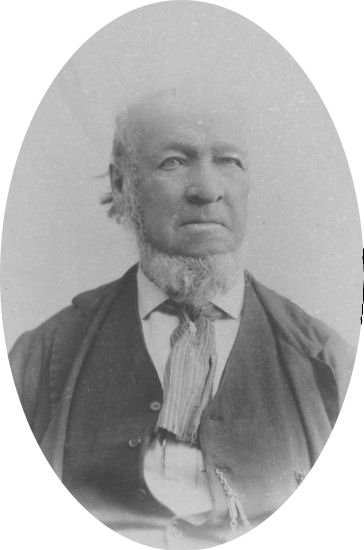
While living in Nauvoo, Gennette's father was one of the personal bodyguards of the Prophet Joseph Smith, for which his life was threatened. One day when he was home with an illness, some men wearing masks on their faces burst into their home. They forced little Gennette and her mother out of the room saying. "You don't want to see what we are going to do to that man." They were armed with long knives and started to slash at him cutting holes in the bedding. Gennette, seeing this, was very frightened. She ran into the street screaming, "They are killing my father, they are killing my father!" Two men ran to help her father, saying, "We are not Mormons, but we do not believe in that." In the meantime, her father prayed for strength, and springing from his bed, he put the mobbers out of the house. Gennette said the sheet had many holes in it but her father did not have a scratch on him. They truly believed that his Heavenly Father protected him to help in the great work, which was just beginning,.
They endured the hardships of persecution and in the fall of 1842 or early spring of 1843, her mother, expecting a second child and being in delicate health, took little Gennette and went to visit her parents in Cincinnati, Ohio. In March her mother was riding in a carriage drawn by a team of spirited horses. They became frightened and ran, throwing her from the carriage, causing the birth of her child, John Rancler Cooley and resulting in her death.
Gennette was seven years of age then. When her mother was dying they called her to the bedside. She was reluctant to go into the room where her mother lay, but her grandmother took her hand and led her to the side of the bed. Her mother, knowing her death was near, wanted to tell her little girl goodbye and to make a request. She said "Gennette, you . . ."
She died before she could finish the sentence. That was March 15, 1843. Gennette always thought her mother was not permitted to finish the request, that it was for her to stay with her grandmother. She was grateful that she was returned to her father and was permitted the privilege of being reared in the church... a way of life she loved.
Her baby brother had to be left with a wet nurse in order to survive. It was agreed that he would stay until he was one year old, then they would return for him. But it was not to be so. Her father returned several times to get the child, but there was always some excuse to keep him. Finally they told him the baby died. Gennette always thought they hid him and that her brother did not die, that he lived to manhood. (In actuality, he died on April 24, 1846.)
At some point in time Gennette's grandmother, Mary Butler Cooley (her father's mother), moved to Nauvoo. Perhaps it was after after mother's death to help raise Gennette.
During the troubled times of 1844 the people in Nauvoo, young and old, lived with a cloud of fear hanging over them. The Prophet Joseph Smith and his brother Hyrum were martyred on June 28th. Gennette was eight years of age then. She saw the bodies and many times told about the bullet hole in Hyrum's face beside his nose.
After the death of Joseph Smith, an atmosphere of uncertainty resided in Nauvoo. The question of who should lead the church was settled when it was made manifest that Brigham Young and the Twelve Apostles were the authorities to whom the members of the church were to look for direction. During this time, Gennette was baptized in Nauvoo on October 20, 1844. With the leadership of the church firmly established, persecutions continued and it was determined that Nauvoo must be abandoned. In February of 1846 the exodus began.
Gennette's father was called by Brigham Young to establish a mill northeast of Winter's Quarters in Pottawattamie County, Iowa. A settlement of several families known as Cooley's Camp or Cooley's Mill was established around the mill. Gennette's Uncle John Gould and his family also lived at Cooley's Camp. He died there as did two of his children.
It was there that in 1849 her father married Susan Jane Hunt. Two children were born to them while living in Iowa, Marietta (8 Sep 1850) and Samuel William (2 Aug 1852). Young Gennette helped with the work in the household, often caring for the children and whatever had to be done.
In April of 1853, the family prepared for the long trip across the plains. The wagons assembled at "Six Mile Grove" on June 9, 1853, under the able leadership of John William Cooley and John Miller. A total of 282 souls and 70 wagons commenced early in the morning for the long journey. Accompanying her father and stepmother, Susan, were Gennette, Marietta, Sammie, and her grandmother, Mary Butler Cooley. Gennette who was then sixteen years old walked and drove an ox team from Council Bluffs, Iowa to Salt Lake City, Utah. There was much heartbreak along the trail. During the night of July 9, 1853, Sammie, her baby half brother, died and was buried at Shepherds Creek. They pressed onward and the company arrived in the Salt Lake Valley on September 9, 1853. For the first couple of years, they resided at Cottonwood (now Holiday, Utah) where they were sent to settle. However, they were not there long and in 1855 they moved to Grantsville, Tooele County.
By
this time Gennette had grown into a beautiful young woman. She was
petite with a trim figure, weighing 115 pounds. She had a sparkling
personality, black hair and dark eyes. She was not musically inclined
but loved to dance. When she danced, she lifted her skirt as her feet
glided across the floor.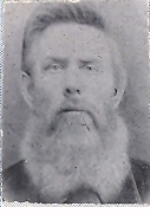
Enoch Rhodes Dayley
In Grantsville, she met and fell in love with Enoch Rhodes Dayley, the son of James Dayley and Isabelle McBride Dayley. They were married December 29, 1856 at Grantsville, Toole County, Utah. In 1858, after the birth of their first child, Enoch Rhodes, Jr. (27 Feb 1858), they moved to Cache Valley where Enoch was called to help with the settlement of Richmond, Cache County, Utah. While living there, three of their children were born; George Owen (14 Feb 1860), James Keller (10 Jun 1862), and, John William (28 May 1865). They remained there until the spring of 1867 when they moved back to Grantsville where four more children were born; Charles Wiseman (14 Jul 1867), Jennette Isabelle who went by Nettie (18 Oct 1871), Porteous Donald (10 Jun 1873), and Mary Hannah (13 Oct 1875). Mary Hannah died a few months later on February 9, 1876.
In
1880 Enoch and Gennette with their family left Grantsville at the
request of Elder Francis M. Lyman
to journey farther north and settled
in Basin, Cassia County, Idaho. Enoch assisted William
C. Martindale and George Whittle organize what was known
as the Goose Creek Branch of the Tooele Stake. Enoch was called as
the second counselor in the branch presidency.
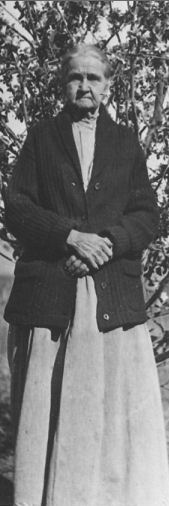
Gennette Cooley Dayley
Gennette was an angel of mercy for the sick and afflicted. She had the gift of healing, ministering to the sick, and knowing just what to do. As a midwife, she officiated at many births. She was willing and glad to help anyone in need. She was a very good midwife and had her little black bag always ready to drive off with her horse and buggy at a minute's notice. For years, she delivered all the babies born in Basin, and many in Oakley as well. She was very accommodating but seldom received any money for her service, as there was very little money in those days. Most of the time she received nothing, occasionally she was paid in produce, eggs, milk or cheese. She was loved and respected by all who knew her. They called her "Aunt Gennette."
She loved to knit. As a child, she was required to knit her own stockings, and those of her younger brothers and sisters. Many a blue ribbon from the County Fair found it's way to her for her beautiful lace bedspreads and the six and eight inch wide lace she created for pillowcases. She was a very talented seamstress.
At a special conference held in Oakley on Saturday November 19, 1887, the Cassia Stake of Zion was organized. The following Tuesday the Basin Ward was created with Enoch Rhodes Dayley as the Bishop, a position in which he served the rest of his life.
In
October 1891 the entire family made a trip to Logan, Utah where she
received her endowments and was sealed to Enoch
in the Logan Temple on October 21, 1891. At that time, all of their
children were also sealed to them, including Mary
Hannah, who was sealed by
proxy.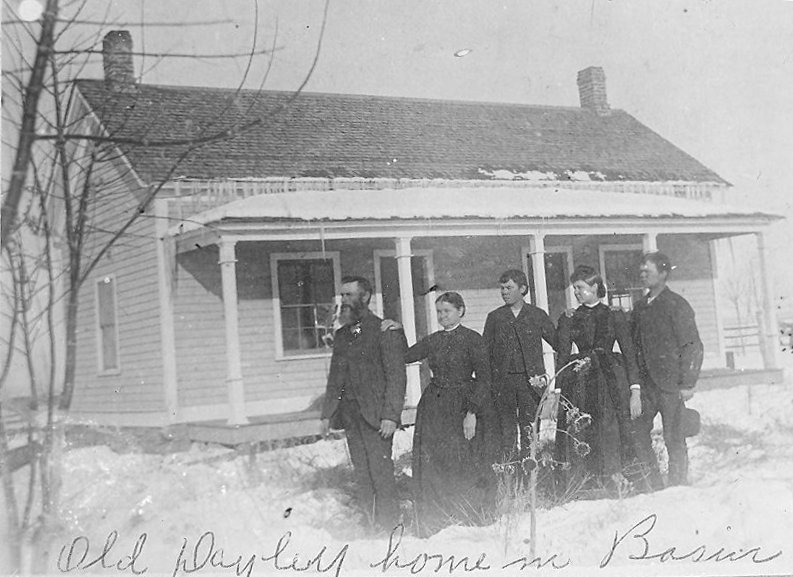
Left to right: Enoch, Gennette,
Porteous, Nettie, and Charles.
Enoch's and Gennette's love for one another was deep and sincere. In the winter of 1892, Gennette became very ill, neigh unto death. Enoch thought he would rather be taken than to live without her. He prayed that her life would be spared and his taken instead. His prayer was answered almost immediately. Gennette was healed as if by a miracle and Enoch 's was taken. He died suddenly on November 13, 1892 at the age of 55. He was laid to rest in the Basin Cemetery.
Gennette loved animals and hated to see them abused. For years she had a flock of chickens. She took good care of them and they produced well. The eggs furnished her with a steady income and she always had a little money as a result.
In
1897, Gennette's father moved to Oakley from Grantsville to live with
Genette and her family. While there John William Cooley passed away
in Oakley on November 17, 1898 at the age of eighty-seven and was
buried in the Basin Cemetery.
Gennette feeding her chickens
She left Basin and moved to Burley where she lived with her daughter, Nettie and David Parker. She had her own room in the front of their house with a door that opened onto the porch. She was always very tidy and did her own housekeeping. She was a lot of fun to be around and had a keen sense of humor. She was good with her grandchildren and played jump rope and hopscotch with them.
Gennette
always seemed to have good health. She always walked to church with
the family. She walked so fast that many times she would get ahead of
them. She was deeply religious and never missed a night kneeling
beside her bed to say her prayers. She was humble and strong in her
convictions. With a moderate education, she was wise in her decisions
and was seldom wrong. She was a very proper lady.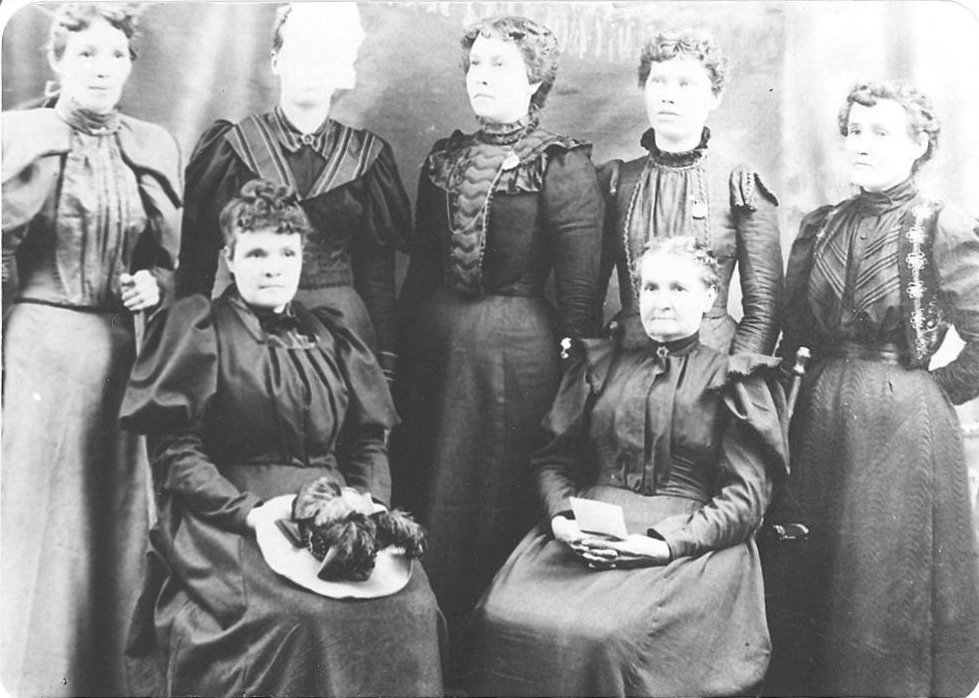
Gennette with her daughter and daughters-in-law. Gennette is
seated on the right with Carrie Sanford Dayley standing behind
her. Nettie Dayley Parker is in the center.
She subscribed to the Deseret News and never missed reading the sermons in the church section. She worried about getting the temple work done for her relatives. On many, many occasions she would say,”I must get the work done because they are waiting for it and they'll never forgive me if I don't do it.”
In
her later years her memory failed her and she was no longer able to
take care of her self. As she became more feeble during the last ten
years of her life, she required constant attention, day and night.
The grandchildren took turns staying with her at night because she
would wander off and get lost.
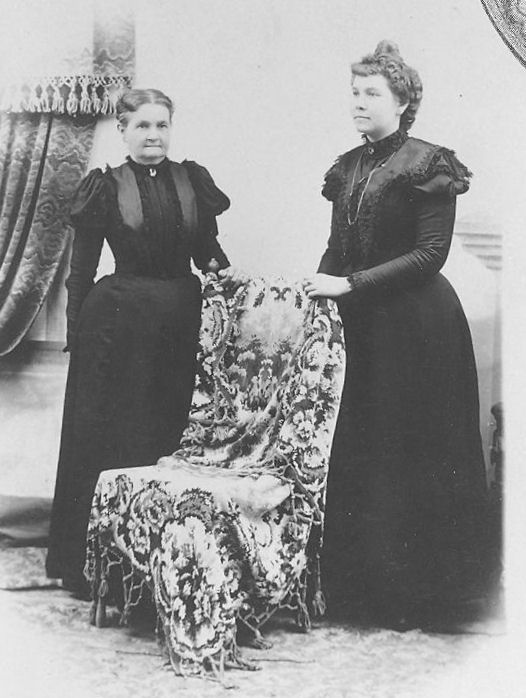
Gennette with her daughter, Nettie
In her mind, she reverted to the days when she was a young woman raising her own family. She lived in the past and talked of events from years ago as if it was in the present. She got to where she didn't recognize her children or her friends. She had a large doll which she called her baby. One day she lost the baby doll. Her son-in-law, David Parker was the principal of the Overland School which was near their home. That day when she misplaced the doll, she left the house and went to the school, crying that she had lost her baby. David dismissed his students and told them to search all around the area to find the doll. The kids were happy to have an unexpected recess, and someone did find the doll for her and she was content.
Gennette Cooley Dayley was indeed a wonderful woman. She lived a life of kindness, gentleness, and service to everyone. She lived through many of the early persecutions of the church, the hardships of the frontier life, and the tragic affects of old age. Through everything, her faith never faltered and she was faithful to the end. She died of pneumonia in her old age at the home of her daughter, Nettie Dayley Parker in Burley, Cassia County, Idaho at the age of ninety-one years, one month, and seventeen days on February 6, 1927. She was laid to rest at the side of her beloved husband in the Basin Cemetery.
* * * * * * *
The main source of this story is from a history written by Bertha Spargo, daughter of Porteious Donald Dayley with remembrances from Lyle Dayley and Vyla Dayley Frost.